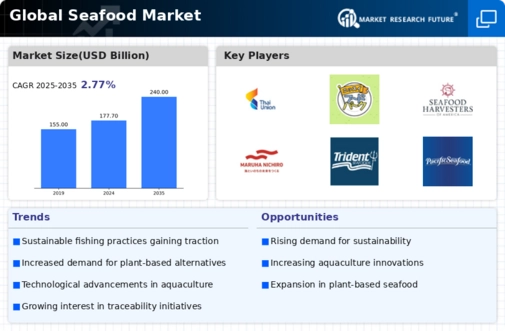Top Industry Leaders in the Seafood Market

Strategies Adopted by Seafood Key Players
The seafood market is marked by a competitive landscape shaped by key players, each employing distinct strategies to navigate the complexities of this dynamic industry.
- Prominent among these key players are Austevoll Seafood ASA (Norway)
- Cooke Aquaculture Inc. (Canada)
- Thai Union Group PCL (Thailand)
- Dongwon Group (South Korea)
- Lyons Seafoods Ltd. (UK)
- Zhanjiang Guolian Aquatic Products Co. Ltd. (China)
- Princes Ltd. (UK)
- Trident Seafoods Corp. (US)
- Tri Marine International Inc. (US)
- Amalgam Enterprises (India)
These industry giants have established themselves through a combination of global market penetration, mergers and acquisitions, and adherence to stringent quality standards.
Strategies adopted by these key players are indicative of the multifaceted approach required to maintain a competitive edge. Thai Union Group, for instance, has prioritized diversification, expanding its product portfolio to include a wide range of seafood offerings. Marine Harvest ASA, on the other hand, has focused on vertical integration, securing control over the entire seafood production process. Clearwater Seafoods has emphasized sustainable practices, aligning its operations with the increasing demand for ethically sourced seafood. Nippon Suisan Kaisha, Ltd. has capitalized on strategic partnerships, forging alliances with distributors and retailers to strengthen its market presence.
Market Share Analysis Factors:
Market share analysis in the seafood industry is influenced by factors such as product quality, pricing, and adherence to sustainability standards. The ability of key players to meet stringent regulatory requirements and maintain consistency in the quality of their seafood products plays a pivotal role in determining market share. Additionally, global distribution networks and efficient supply chain management contribute significantly to the competitive standing of companies in this sector. As consumer preferences evolve, factors such as the availability of diverse product offerings and responsiveness to market trends become key drivers for securing and expanding market share.
New & Emerging Companies:
In the ever-evolving seafood market, new and emerging companies are making noteworthy strides, challenging the dominance of established players. Companies like Mowi ASA and High Liner Foods have emerged as contenders, leveraging niche segments and adapting to changing consumer preferences. These newcomers often bring innovation and agility to the market, addressing specific demands and carving out a space for themselves alongside the industry giants.
Industry Trends:
Industry news and current investment trends reveal a collective effort among key players to address sustainability concerns and invest in technological advancements. Sustainable fishing practices, aquaculture development, and traceability initiatives are focal points for investments. Companies are increasingly allocating resources to enhance their processing capabilities, ensuring compliance with environmental standards, and adopting technologies that improve efficiency in seafood production. Furthermore, strategic mergers and acquisitions are prevalent, enabling companies to strengthen their market positions, expand product portfolios, and achieve economies of scale.
Competitive Scenario:
The overall competitive scenario in the seafood market is characterized by a blend of established players defending their positions and new entrants disrupting the status quo. The established players, with their extensive resources and global reach, maintain dominance through economies of scale and robust distribution networks. Meanwhile, emerging companies bring agility and innovation, challenging traditional business models and driving industry-wide evolution.
Recent Development
Recent developments underscore the industry's commitment to sustainability and responsible practices. Companies are increasingly focusing on eco-friendly packaging, reducing the environmental impact of their operations, and implementing transparent supply chain practices. Additionally, there has been a surge in the development and promotion of plant-based and alternative seafood products, aligning with the growing trend toward plant-centric diets and addressing concerns about overfishing and environmental sustainability.


